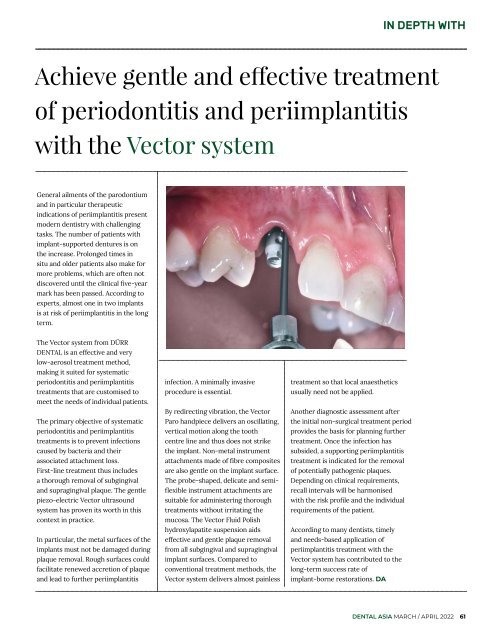Dental Asia March/April 2022
For more than two decades, Dental Asia is the premium journal in linking dental innovators and manufacturers to its rightful audience. We devote ourselves in showcasing the latest dental technology and share evidence-based clinical philosophies to serve as an educational platform to dental professionals. Our combined portfolio of print and digital media also allows us to reach a wider market and secure our position as the leading dental media in the Asia Pacific region while facilitating global interactions among our readers.
For more than two decades, Dental Asia is the premium journal in linking dental innovators and manufacturers to its rightful audience. We devote ourselves in showcasing the latest dental technology and share evidence-based clinical philosophies to serve as an educational platform to dental professionals. Our combined portfolio of print and digital media also allows us to reach a wider market and secure our position as the leading dental media in the Asia Pacific region while facilitating global interactions among our readers.
- No tags were found...
You also want an ePaper? Increase the reach of your titles
YUMPU automatically turns print PDFs into web optimized ePapers that Google loves.
IN DEPTH WITH<br />
Achieve gentle and effective treatment<br />
of periodontitis and periimplantitis<br />
with the Vector system<br />
General ailments of the parodontium<br />
and in particular therapeutic<br />
indications of periimplantitis present<br />
modern dentistry with challenging<br />
tasks. The number of patients with<br />
implant-supported dentures is on<br />
the increase. Prolonged times in<br />
situ and older patients also make for<br />
more problems, which are often not<br />
discovered until the clinical five-year<br />
mark has been passed. According to<br />
experts, almost one in two implants<br />
is at risk of periimplantitis in the long<br />
term.<br />
The Vector system from DÜRR<br />
DENTAL is an effective and very<br />
low-aerosol treatment method,<br />
making it suited for systematic<br />
periodontitis and periimplantitis<br />
treatments that are customised to<br />
meet the needs of individual patients.<br />
The primary objective of systematic<br />
periodontitis and periimplantitis<br />
treatments is to prevent infections<br />
caused by bacteria and their<br />
associated attachment loss.<br />
First-line treatment thus includes<br />
a thorough removal of subgingival<br />
and supragingival plaque. The gentle<br />
piezo-electric Vector ultrasound<br />
system has proven its worth in this<br />
context in practice.<br />
In particular, the metal surfaces of the<br />
implants must not be damaged during<br />
plaque removal. Rough surfaces could<br />
facilitate renewed accretion of plaque<br />
and lead to further periimplantitis<br />
infection. A minimally invasive<br />
procedure is essential.<br />
By redirecting vibration, the Vector<br />
Paro handpiece delivers an oscillating,<br />
vertical motion along the tooth<br />
centre line and thus does not strike<br />
the implant. Non-metal instrument<br />
attachments made of fibre composites<br />
are also gentle on the implant surface.<br />
The probe-shaped, delicate and semiflexible<br />
instrument attachments are<br />
suitable for administering thorough<br />
treatments without irritating the<br />
mucosa. The Vector Fluid Polish<br />
hydroxylapatite suspension aids<br />
effective and gentle plaque removal<br />
from all subgingival and supragingival<br />
implant surfaces. Compared to<br />
conventional treatment methods, the<br />
Vector system delivers almost painless<br />
treatment so that local anaesthetics<br />
usually need not be applied.<br />
Another diagnostic assessment after<br />
the initial non-surgical treatment period<br />
provides the basis for planning further<br />
treatment. Once the infection has<br />
subsided, a supporting periimplantitis<br />
treatment is indicated for the removal<br />
of potentially pathogenic plaques.<br />
Depending on clinical requirements,<br />
recall intervals will be harmonised<br />
with the risk profile and the individual<br />
requirements of the patient.<br />
According to many dentists, timely<br />
and needs-based application of<br />
periimplantitis treatment with the<br />
Vector system has contributed to the<br />
long-term success rate of<br />
implant-borne restorations. DA<br />
DENTAL ASIA MARCH / APRIL <strong>2022</strong> 61


















